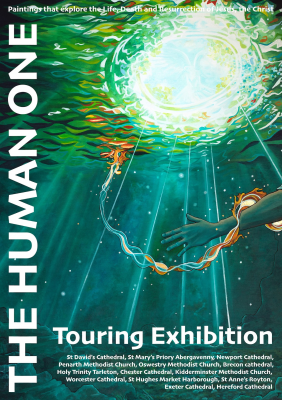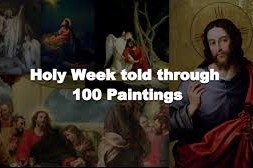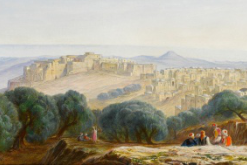Oldham: Exhibition - The Human One

The Human One: Paintings that explore the Life, Death and Resurrection of Jesus, the Christ , is an exhibition of the work of Jeremy Thomas, artist in residence at St Mary's Priory in Abergavenny.
I was privileged to see this beautiful exhibition at St Anne's church in Royton, Oldham, where it continues this weekend, and where the warmth of the welcome adds to the enjoyment of the experience.
The paintings lead the viewer around the early twentieth century church, starting with 'In the beginning was the Word.' This is a cosmic painting full of dark depths and emerging light, which could have been inspired by an image from a space telescope. Then, with Zacharias and The Annunciation we are in a world of brilliant light and joyful colour, dominated by vibrant yellows, greens and blues.
As the narrative progresses, the artist uses a technique which compels us to look closely at his work, inviting us in, to become seekers of meaning. There are many symbols and details which can be easily missed on first looking, and this makes a close examination of the pictures very rewarding. In the moving painting of the Gerasene Demoniac, for instance, where Jesus tenderly and respectfully approaches the tormented man in his cave of isolation and exclusion, disturbing faces emerge from the rocks surrounding him, making his torment visible. In Zacchaeus, under the large tree in the foreground, all we see of the tax collector is a bag of coins and a pair of sandals, which Zacchaeus has discarded as he goes to follow Jesus, a tiny figure radiating light, in the middle of a crowd in the far distance.
Another way in which Thomas draws us in to the story is that, rather than the subject of the painting dominating the picture, he often makes it a small, almost hidden detail. In The Last Supper for instance, we see an ancient town in earthy shades of brown and ochre, underneath a midnight blue sky. It is a scene cloaked in darkness, but when we look closely, in one of the windows there is a light, in which we can see the tiny figures of Jesus and his disciples, sharing bread and wine.
St Anne's vicar Liz Devall, who is rightly delighted to have secured the exhibition for her parish, revealed that while adults sometimes don't see these details on a first viewing, this was not the case with the children from the primary school. In Palm Sunday for example, there is a figure in the foreground treading a palm-strewn street, who looks rather typically Christ-like. Many adults assume this is Jesus, but the children knew that it was the smaller figure on a donkey, half hidden in the background, who is actually Jesus.
This technique, of locating a profound and significant event on the margins of a painting, or rendering it in a way which means it could be overlooked, brought to mind WH Auden's poem, Musee des Beaux Arts.
See: www.poetrybyheart.org.uk/poems/mus-e-des-beaux-arts
As Auden wrote:
About suffering they were never wrong,
The Old Masters..…
They never forgot
That even the dreadful martyrdom must run its course
Anyhow in a corner, some untidy spot
Where the dogs go on with their doggy
life and the torturer's horse
Scratches its innocent behind on a tree.
This to me goes to the heart of the exhibition and is the key to its success - the seamless marriage of the intensely personal, human and vulnerable with the profoundly universal, powerful and momentous. The artist's way of sometimes looking at familiar events from a slightly different angle contributes to this duality. Feeding The Five Thousand for instance, portrays Jesus not in the midst of a crowd performing the miracle, but afterwards, when the crowds have disappeared and he is a solitary figure by the lakeside, praying alone. To me, this was a rather moving summation of the exhibition's title: The Human One.
This is not the first time that St Anne's Royton has secured distinguished art. www.manchestereveningnews.co.uk/news/local-news/haunting-sculpture-is-back-on-display-883273 The church is now home to Dachau, an almost grotesque crucified figure made as a testament to human suffering, by Liverpool sculptor Arthur Dooley, a Catholic convert and committed Communist. This powerful and disturbing work is situated close to Thomas's darkest paintings of events at the end of Jesus's life, creating a remarkable and memorable extra dimension to the experience in this venue.
Thomas's work is quite clearly the product of a deep and prayerful engagement with the Gospels, but that is not to say it can only be enjoyed by Christians or people of faith. Each painting is accompanied by the relevant Gospel verses, but even without them, the paintings can be enjoyed simply as beautiful works of art.
I was not surprised to learn that Thomas had been a primary school teacher for 15 years. Whilst his paintings are full of symbolism and layers of meaning, they are also extremely engaging and accessible, like the very best illustrations for children's books. This is not to detract from their artistic worth, but to enhance it. Producing work which can speak to people of all ages about themes of life and death, power and vulnerability is surely a great achievement for any artist.
In his desire to reach as many people as possible, Jeremy Thomas would like The Human One not to be confined to churches and cathedrals, and invites anyone who has a suitable space, like a pop-up shop or village hall, to contact him. As he says, "the story has no boundaries".
I would encourage anyone who can to visit this exhibition. It remains in Oldham this weekend (23 and 24 September)
Details here: www.achurchnearyou.com/church/15992/page/82507/view/ and will be in Hereford Cathedral in February 2024.
Explore all of Jeremy Thomas's work and contact him via his website: www.jeremythomasart.co.uk/


















